
|
|
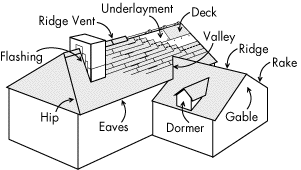
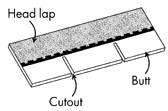
Algae Discoloration - A type of roof discoloration caused by algae. Commonly called fungus growth.
ASTM - American Society for Testing and Materials. A voluntary organization concerned with development of consensus standards, testing procedures and specifications.
Asphalt - A bituminous waterproofing agent applied to roofing materials during manufacture.
Asphalt Plastic Roofing Cement - An asphalt based cement used to bond roofing materials. Also known as flashing cement or mastic; should conform to ASTM D-4586.
Back Surfacing - Fine mineral matter applied to the back side of shingles to keep them from sticking.
Base flashing - That portion of the flashing attached to or resting on the deck to direct the flow of water onto the roof covering.
Blisters - Bubbles that may appear on the surface of asphalt roofing after installation.
Bundle - A package of shingles. There are 3, 4 or 5 bundles per square.
Butt Edge - The lower edge of the shingle tabs.
Caulk - To fill a joint with mastic or asphalt cement to prevent leaks.
Cement - See Asphalt plastic roofing cement.
Chalk Line - A line made on the roof by snapping a taut string or cord dusted with chalk. Used for alignment purposes.
Class "A" - The highest fire-resistance rating for roofing as per ASTM E-108. Indicates roofing is able to withstand severe exposure to fire originating from sources outside the building.
Class "B" - Fire-resistance rating that indicates roofing materials is able to withstand moderate exposure to fire originating from sources outside the building.
Closed Cut Valley - A method of valley treatment in which shingles from one side of the valley extend across the valley while shingles from the other side are trimmed 2 inches from the valley centerline. The valley flashing is not exposed.
Coating - A layer of viscous asphalt applied to the base material into which granules or other surfacing is embedded.
Collar - Pre-formed flange placed over a vent pipe to seal the roof around the vent pipe opening Also called a vent sleeve.
Counter Flashing - That portion of the flashing attached to a vertical surface to prevent water from migrating behind the base flashing.
Course - A row of shingles or roll roofing running the length of the roof.
Coverage - Amount of weather protection provided by the roofing material. Depends on number of layers of material between the exposed surface of the roofing and the deck; i.e., single coverage, double coverage, etc.
Cricket - A peaked saddle construction at the back of a chimney to prevent accumulation of snow and ice and to deflect water around the chimney.
Cutout - The open portions of a strip shingle between the tabs.
Deck - The surface, installed over the supporting framing members, to which the roofing is applied.
Dormer - A framed window unit projecting through the sloping plane of a roof.
Drip Edge - A non-corrosive, non-staining material used along the eaves and rakes to allow water run-off to drip clear of underlying construction.
Eaves - The horizontal, lower edge of a sloped roof.
Exposure - That portion of the roofing exposed to the weather after installation.
Feathering Strips - Tapered wood filler strips placed along the butts of old wood shingles to create a level surface when re-roofing over existing wood shingle roofs. Also called horsefeathers.
Felt - Fibrous material saturated with asphalt and used as an underlayment of sheathing paper.
Fiber Glass Mat - An asphalt roofing base material manufactured from glass fibers.
Flashing - Pieces of metal or roll roofing used to prevent seepage of water into a building around any intersection or projection in a roof such as vent pipes, chimneys adjoining walls, dormers and valleys. Galvanized metal flashing should be minimum 26-gauge.
Flashing Cement - See asphalt plastic roofing cement.
Fungus - See "algae discoloration."
Gable - The upper portion of a sidewall that comes to a triangular point at the ridge of a sloping roof.
Gable Roof - A type of roof containing sloping planes of the same pitch on each side of the ridge. Contains a gable at each end.
Gambrel Roof - A type of roof containing two sloping planes of different pitch on each side of the ridge. The lower plane has a steeper slope that the upper. Contains a gable at each end.
Granules - Ceramic-coated colored crushed rock that is applied to the exposed surface of asphalt roofing products.
Gutter - The trough that channels water from the eaves to the downspouts.
Head Lap - Shortest distance from the butt edge of an overlapping shingle to the upper edge of a shingle in the second course below. The triple coverage portion of the top lap of strip shingles.
Hip - The inclined external angle formed by the intersection of two sloping roof planes. Runs from the ridge to the eaves
Hip Roof - A type of roof containing sloping planes of the same pitch on each of four sides. Contains no gables.
Hip Shingles - Shingles used to cover the inclined external angle formed by the intersection of two sloping roof planes.
Horsefeathers - See feathering strips.
Ice Dam - Condition formed at the lower roof edge by the thawing and re-freezing of melted snow on the overhang. Can force water up and under shingles, causing leaks.
Interlocking Shingles - Individual shingles that mechanically fasten to each other to provide wind resistance.
Laminated Shingles - Strip shingles containing more than one layer of tabs to create extra thickness. Also called three-dimensional shingles or architectural shingles.
Lap - To cover the surface of one shingle or roll with another. Low slope application - Method of installing asphalt shingles on roof slopes between 2 and 4 inches per foot.
Mansard Roof - A type of roof containing two sloping planes of different pitch on each of four sides. The lower plane has a much steeper pitch that the upper, often approaching vertical. Contains no gables.
Mastic - See asphalt plastic roofing cement.
Nesting - A method of re-roofing with new asphalt shingles over old shingles in which the top edge of the new shingle is butted against the bottom edge of the existing shingle tab.
No-Cutout Shingles - Shingles consisting of a single solid tab with no cutouts.
Normal Slope Application - Method of installing asphalt shingles on roof slopes between 4 inches and 21 inches per foot
Open Valley - Method of valley construction in which shingles on both sides of the valley are trimmed along a chalk line snapped on each side of the valley. Shingles do not extend across the valley. Valley flashing is exposed.
Organic Felt - An asphalt roofing base material manufactured from cellulose fibers.
Overhang - That portion of the roof structure that extends beyond the exterior walls of a building.
Overlay Shingle - A one-piece base shingle to which overlay pads, consisting of an additional layer of asphalt and granules, are applied in random patterns to simulate two-piece laminated shingles.

Pitch - The degree of roof incline expressed as the ratio of the rise, in feet, to the span, in feet.
Rafter - The supporting framing member immediately beneath the deck, sloping from the ridge to the wall plate.
Rake - The inclined edge of a sloped roof over a wall.
Random-Tab Shingles - Shingles on which tabs vary in size and exposure.
Release Tape - A plastic or paper strip that is applied to the back of self-sealing shingles. This strip prevents the shingles from sticking together in the bundles, and need not be removed for application.
Ridge - The uppermost, horizontal external angle formed by the intersection of two sloping roof planes.
Ridge Shingles - Shingles used to cover the horizontal external angle formed by the intersection of two sloping roof planes.
Roll Roofing - Asphalt roofing products manufactured in roll form.
Saturated Felt - An asphalt-impregnated felt used as an underlayment between the deck and the roofing material.
Self-Sealing Shingles - Shingles containing factory-applied strips or spots of self-sealing adhesive.
Shading - Slight differences in shingle color that may occur as a result of normal manufacturing operations.
Shangle - the product design concept originated by CertainTeed that was the original laminated shingle. The Shangle features a full size, one piece shingle as a base. Individual shingle tabs or overlay pads are applied to this base shingle providing a dimensional look to the roof.
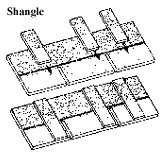
Super ShangleŽ - a patented CertainTeed design in which
two 18-inch by 36-inch shingles are laminated together and may feature randomly
applied tabs and shadow line accents. The Super Shangle features a full 8-inch
exposure versus five inches for most other types of shingles.
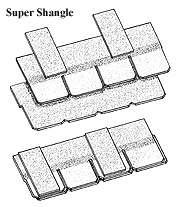
Sheathing - Exterior grade boards used as a roof deck material.
Shed Roof - A roof containing only one sloping plane. Has no hips, ridges, valleys or gables.
Slope - The degree of roof incline expressed as the ratio of the rise, in inches, to the run, in feet.
Soffit - The finished underside of the eaves.
Soil Stack - A vent pipe that penetrates the roof.
Square - A unit of roof measure covering 100 square feet.
Starter Strip - Asphalt roofing applied at the eaves that provides protection by filling in the spaces under the cutouts and joints of the first course of shingles.
Steep Slope Application - Method of installing asphalt shingles on roof slopes greater than 21 inches per foot.
Step Flashing - Flashing application method used where a vertical surface meets a sloping roof plane.
Strip Shingles - Asphalt shingles that are approximately three times as long as they are wide.

Tab - The exposed portion of strip shingles defined by cutouts.
Telegraphing - A shingle distortion that may arise when a new roof is applied over an uneven surface.
Three-Dimensional Shingles - See laminated shingles.
Two-Piece Laminate - (also called "LAMINATE"): a top shingle with sections cut away creating "tabs" of the remaining shingle. This top portion is then laminated to a half shingle which backs the exposed sections. The total effect is multi-layered, dimensional appearance.
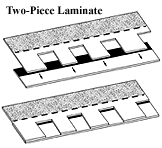
UL - Underwriters Laboratories, Inc.
UL Label - Label displayed on packaging to indicate the level of fire and/or wind resistance of asphalt roofing.
Underlayment - Asphalt saturated felt used beneath roofing to provide additional protection for the deck.
Valley - The internal angle formed by the intersection of two sloping roof planes.
Vapor Retarder - Any material used to prevent the passage of water vapor
Vent - Any outlet for air that protrudes through the roof deck such as a pipe or stack. Any device installed on the roof, gable or soffit for the purpose of ventilating the underside of the roof deck.
Vent Sleeve - See collar.
Woven Valley - Method of valley construction in which shingles from both sides of the valley extend across the valley and are woven together by overlapping alternate courses as they are applied. The valley flashing is not exposed.